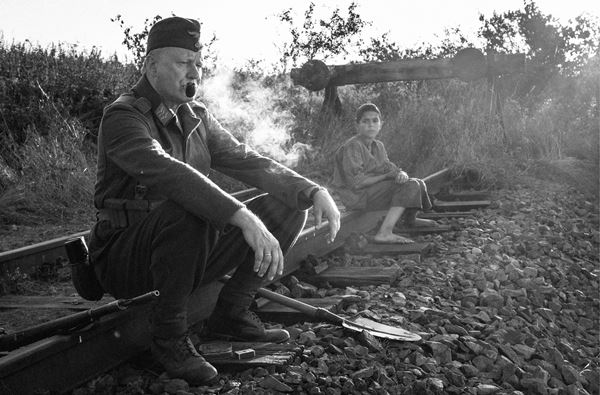

In the scene that explains The Painted Bird’s title, a nameless boy, played by Petr Kotlar, watches a bird breeder release one bird into the air with its wings brightly painted. Because of its cosmetic difference, it’s erratically swarmed and killed by other birds for the simple crime of appearing foreign. This disturbing moment is a microcosm of the film’s hostile environment: a country ravaged by war but governed by its citizen’s embrace of cruelty as their de facto emotion. Viewers watch the Boy endure three hours of abuse and persecution inside it in an unorthodox Holocaust-centric drama that sets a new template for “pure cinema” of sight and sound.
Directed by Czech filmmaker Vaclav Marhoul and based on the 1965 novel by Jerzy Kosinski, The Painted Bird is an emotionally draining story that I would only recommend to those with very strong stomachs. The first half hour alone is enough to make viewers uncomfortable due to how much cruelty is depicted, including our first interaction with the Boy. Failing to evade some kids in a forest, he’s beaten up and forced to watch the boys set his pet ferret on fire. His aunt—whom the Boy’s lives with at his parent’s behest while they evade the Nazis—shows little sympathy for his loss because he went outside without her supervision. Immediately the world’s nihilistic outlook is made clear: this is a bleak place, and nothing can be done beyond survival.
Then the Boy’s aunt dies in the middle of the night, without warning, and he begins a grueling journey across Eastern Europe to find his parents, always running into some individual, group, or village that treats him somewhere between an abuse victim and the spawn of Satan. Maybe it’s because he’s Jewish, maybe it’s because he’s an outsider, but more often than not it feels like they do it just because. This lack of empathy seals the fates of millions of Jews during the Holocaust and turns village inhabitants against one another simply because the option is available.
Each subsequent interaction between the Boy and others makes the previous encounter somehow feel less depraved. An old mill owner beats his wife for looking passionately at a young worker and then spoons out the latter’s eyes; a promiscuous woman is raped by her town’s women in fear that she’ll come for their husbands; a supposedly decent churchgoer turns out to be a pedophile, just to name a few.
These interactions gradually render the Boy mute. He refrains from talking to anyone save animals, his last connection to warm-blooded innocence. Kotlar effectively acts through passively reacting, becoming a cipher for the audience to wade further into the muck of this cruel world, like the donkey in Au Hasard Balthazar. Eventually he too is corrupted, proving equally capable of inflicting violence onto those who’ve wronged him.
Director Marhoul conveys these raw emotions not through words but an atmospheric visual dialect similar to Andrei Tartovsky’s films (Stalker, Mirror). Aided by Vladimír Smutny’s cinematography, The Painted Bird is just as aesthetically minimalist as the depiction of the Boy, with long scenic shots, ambient noise, and a voyeuristic eye for nature and human destruction caught on black-and-white 35mm and filmed in the 1:2.35 aspect ratio. These visuals are gorgeous for their haunting nature, shaping us, through the Boy’s perspective, to the point that you’ll share his thousand-yard stare by the end.
This is the first movie to use Interslavic language, a conscious decision by Marhoul to avoid linking his story’s all-encompassing evil to any one Slavic country. Its cast is mostly from that region, save for a few well-known faces like Stellan Skarsgard as a Nazi soldier (with no lines, shockingly), Harvey Keitel as a priest, Julian Sands (Leaving Las Vegas) as the aforementioned pedophile, and Barry Pepper (Saving Private Ryan, The Green Mile) as a Soviet sniper. The last one stands out as one of the few positive relationships the Boy has without repercussions, as those who show kindness are often abused or left ruined by their neighbors. While Nazis appear in a few scenes, including one dark moment involving a concentration camp train, they’re framed as a small evil compared to the region’s native population.
I can’t say I’d ever want to watch The Painted Bird again, but it’s undoubtedly a masterpiece of visual storytelling. Those who endure its excruciating events will be left with a protagonist who, despite saying almost nothing, emotes how we all may feel: scarred but somehow possessing the strength to keep going. His final actions suggest that, despite losing his innocence long ago, he’s not totally lost just yet.






Leave A Comment